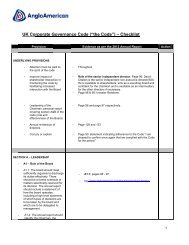Creating Value with the Future in Mind - Anglo American South Africa
Creating Value with the Future in Mind - Anglo American South Africa
Creating Value with the Future in Mind - Anglo American South Africa
Create successful ePaper yourself
Turn your PDF publications into a flip-book with our unique Google optimized e-Paper software.
01<br />
02<br />
Waste utilisation<br />
At our Phosphates operation <strong>in</strong><br />
Brazil, we are employ<strong>in</strong>g our<br />
approach of ‘reduce, re-use, recycle’<br />
on an <strong>in</strong>dustrial scale to improve<br />
<strong>the</strong> way we utilise waste products.<br />
As one of <strong>the</strong> largest producers<br />
of phosphate fertilisers <strong>in</strong> Brazil,<br />
<strong>Anglo</strong> <strong>American</strong> produces around<br />
1.35 million tonnes (Mt) of phosphate<br />
concentrate every year to facilitate its<br />
production. As a result, <strong>the</strong> effluent<br />
treatment plant associated <strong>with</strong><br />
<strong>the</strong> fertiliser production process<br />
generates around 7,800 tonnes of<br />
phosphate waste annually. The waste<br />
comes <strong>in</strong> <strong>the</strong> form of a cake rich <strong>in</strong><br />
P 2 O 5 – a powerful desiccant and<br />
dehydrat<strong>in</strong>g agent.<br />
Despite <strong>the</strong> potentially beneficial<br />
properties of <strong>the</strong> waste material,<br />
only about 20% of this cake was<br />
previously available to be re-used,<br />
namely <strong>in</strong> <strong>the</strong> granulation stage of<br />
<strong>the</strong> phosphate fertiliser production<br />
process. The rema<strong>in</strong>der was ei<strong>the</strong>r<br />
sold as a low-value by-product or<br />
disposed – rais<strong>in</strong>g environmental<br />
concerns. However, follow<strong>in</strong>g a<br />
series of lab and <strong>in</strong>dustrial scale<br />
tests and much persistence from <strong>the</strong><br />
team at Cubatão, results showed that<br />
<strong>the</strong> phosphate waste could also be<br />
used <strong>in</strong> <strong>the</strong> acidulation process – <strong>the</strong><br />
first stage <strong>in</strong> <strong>the</strong> fertilisermanufactur<strong>in</strong>g<br />
process – reduc<strong>in</strong>g<br />
<strong>the</strong> need for new water and creat<strong>in</strong>g<br />
value from a waste material.<br />
After <strong>the</strong> success of <strong>the</strong> tests, <strong>the</strong><br />
new technique also entered full-scale<br />
production at Catalão <strong>in</strong> March 2012,<br />
achiev<strong>in</strong>g sav<strong>in</strong>gs of 48,000 tonnes<br />
of phosphate concentrate <strong>in</strong> 2012<br />
as a result. We also saw a sav<strong>in</strong>g of<br />
over 13 million litres of water <strong>in</strong> acid<br />
dilution and a reduction of 10 tonnes<br />
of CO 2 emissions at <strong>the</strong> dry<strong>in</strong>g plant.<br />
As well as reduc<strong>in</strong>g production<br />
costs, this research and development<br />
is set to have long-term benefits<br />
for <strong>the</strong> environment. Recent figures<br />
show that <strong>the</strong> amount of phosphate<br />
waste recovered and re-used has<br />
<strong>in</strong>creased to 40% – a figure which<br />
could rise to 60% <strong>in</strong> <strong>the</strong> future –<br />
and <strong>the</strong> amount of waste disposed<br />
of <strong>in</strong> <strong>the</strong> environment has<br />
decreased accord<strong>in</strong>gly.<br />
Images<br />
01 Process<strong>in</strong>g plant and water treatment area at<br />
Phosphates’ Cubatão operation <strong>in</strong> São Paulo<br />
state, Brazil.<br />
02 Featured <strong>in</strong> Phosphates’ chemical laboratory<br />
at Cubatão, Brazil, is Thiago Araujo, who was<br />
an Applaud Susta<strong>in</strong>ability f<strong>in</strong>alist <strong>in</strong> 2012 for<br />
develop<strong>in</strong>g a process to extract value from<br />
waste slurry.<br />
Currently, <strong>the</strong>re is no cost-effective<br />
solution available to recycle waste<br />
tyres from our operations. We are<br />
work<strong>in</strong>g <strong>with</strong> a company that is<br />
develop<strong>in</strong>g a solution to turn <strong>the</strong>se<br />
tyres <strong>in</strong>to value-added products such<br />
as fuels. This may also provide an<br />
<strong>in</strong>vestment opportunity for our new<br />
Zimele Green Fund.<br />
Engagement and partnerships<br />
We are <strong>in</strong>creas<strong>in</strong>gly recycl<strong>in</strong>g<br />
non-m<strong>in</strong>eral waste and identify<strong>in</strong>g<br />
opportunities to engage local<br />
communities <strong>in</strong> projects that deliver<br />
considerable social benefits.<br />
At El Soldado <strong>in</strong> Chile, for <strong>in</strong>stance,<br />
workshops were held <strong>in</strong> <strong>the</strong> local town<br />
of El Melón to teach local women skills<br />
to use waste pallets and paper from our<br />
copper m<strong>in</strong>e to create furniture and<br />
craft paper products. The project<br />
has significantly reduced waste from<br />
<strong>the</strong> operation and has given more<br />
than 2,000 women new skills and<br />
enterprise-development opportunities.<br />
Our Union plat<strong>in</strong>um m<strong>in</strong>e <strong>in</strong> <strong>South</strong><br />
<strong>Africa</strong> has established <strong>the</strong> Vukuzenzele<br />
waste recovery project, which was<br />
implemented follow<strong>in</strong>g <strong>the</strong> unsafe and<br />
illegal scaveng<strong>in</strong>g that took place at<br />
<strong>the</strong> operation’s landfill site by people<br />
from a local <strong>in</strong>formal settlement.<br />
M<strong>in</strong>e employees engaged <strong>with</strong> <strong>the</strong><br />
community to better understand <strong>the</strong>ir<br />
needs; <strong>the</strong> outcome is that <strong>the</strong> waste<br />
reclaimers now have <strong>the</strong> ability to<br />
carry out <strong>the</strong>ir searches safely and<br />
<strong>with</strong> <strong>the</strong> opportunity to earn a<br />
legitimate <strong>in</strong>come.<br />
Our performance<br />
Fifty-four of our 126 large-volume<br />
m<strong>in</strong>eral residue facilities are currently<br />
operative. The total number of m<strong>in</strong>eral<br />
residue facilities has decreased<br />
follow<strong>in</strong>g <strong>the</strong> sale of Scaw Metals’<br />
operations <strong>in</strong> 2011 and 2012. Dur<strong>in</strong>g<br />
<strong>the</strong> year, 69 facilities were audited and<br />
no significant <strong>in</strong>cidents of structural<br />
<strong>in</strong>tegrity loss or environmental harm<br />
related to spillages were recorded.<br />
Where significant risks are identified,<br />
measures are put <strong>in</strong> place to<br />
address <strong>the</strong>se.<br />
Given <strong>the</strong> nature of our bus<strong>in</strong>ess,<br />
we have focused our efforts on<br />
m<strong>in</strong>eral residue as our most material<br />
waste-related risk. Reduction/<br />
recycl<strong>in</strong>g targets related to nonm<strong>in</strong>eral<br />
waste have been set at <strong>the</strong><br />
discretion of <strong>in</strong>dividual bus<strong>in</strong>ess<br />
units and operations.<br />
Our aim is to ensure that our<br />
performance <strong>in</strong> relation to air quality<br />
rema<strong>in</strong>s <strong>with</strong><strong>in</strong> legal limits. Our most<br />
material Group-wide air quality issue<br />
relates to SO 2 emissions around our<br />
copper and plat<strong>in</strong>um smelters. These<br />
amounted to 40,644 tonnes of SO 2 <strong>in</strong><br />
2012 (2011: 41,295 tonnes). In 2013,<br />
we will beg<strong>in</strong> to collect Group-wide<br />
data on SO x and NO x emissions<br />
associated <strong>with</strong> <strong>the</strong> combustion<br />
of diesel and explosives. More<br />
<strong>in</strong>formation on SO 2 emissions around<br />
our plat<strong>in</strong>um smelters is available <strong>in</strong><br />
<strong>the</strong> 2012 Plat<strong>in</strong>um Integrated Report.<br />
Manag<strong>in</strong>g our impact on <strong>the</strong> environment<br />
<strong>Anglo</strong> <strong>American</strong> plc Susta<strong>in</strong>able Development Report 2012 67



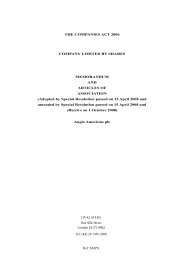
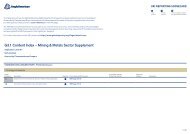
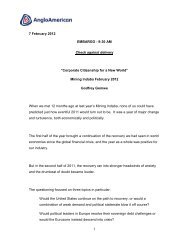
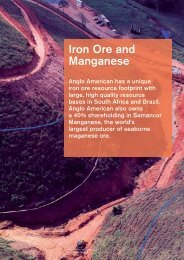
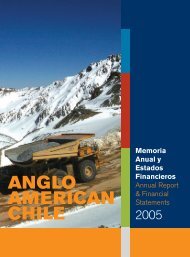
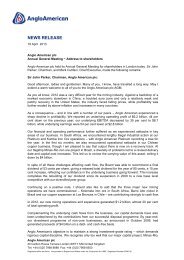
![English PDF [ 189KB ] - Anglo American](https://img.yumpu.com/50470814/1/184x260/english-pdf-189kb-anglo-american.jpg?quality=85)
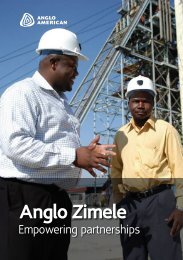

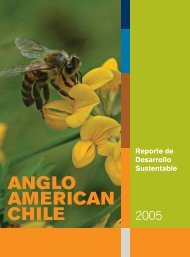

![pdf [ 595KB ] - Anglo American](https://img.yumpu.com/49420483/1/184x260/pdf-595kb-anglo-american.jpg?quality=85)
![pdf [ 1.1MB ] - Anglo American](https://img.yumpu.com/49057963/1/190x240/pdf-11mb-anglo-american.jpg?quality=85)
